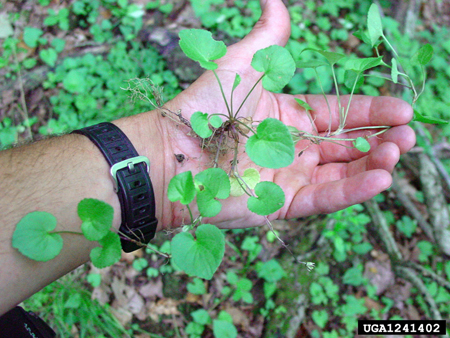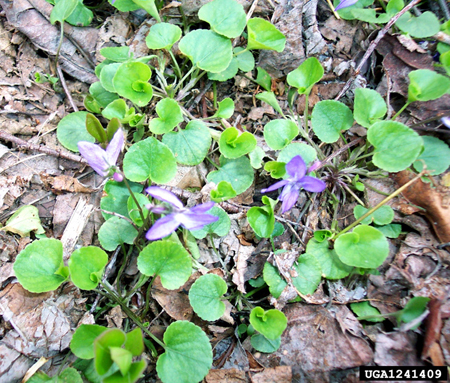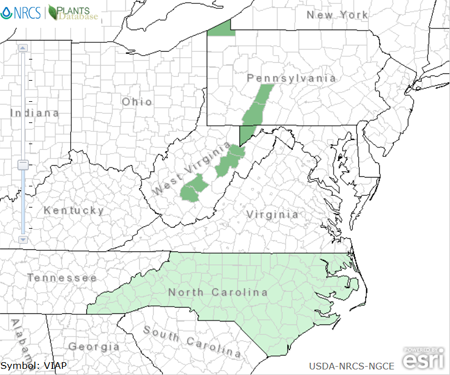Viola appalachiensis L.K.Henry
Common names:
Appalachian Violet, Henry's Violet
Synonyms:
Viola appalachiensis L.K.Henry, Castanea 18: 131. 1953; Viola walteri House var. appalachiensis (L.K.Henry) L.E.McKinney ex S.P.Grund & B.L.Isaac, Castanea 72(1): 59. 2007; Viola allegheniensis L.K.Henry, Castanea 18: 53, pl. 2. 1953. TYPE: U.S.A. Pennsylvania, Somerset Co.: 2.5 mi SE of Somerset on Rt. 219, along Kimberly Run, 13 May 1950, L. K. Henry & W. E. Buker s.n. (LECTOTYPE (designated by Grund & Isaac, Castanea 72: 59. 2007): CM107915!; isolectotype, CM0064). [Henry's publication of Viola alleghaniensis erroneously states "...flood-plain of Kimberly Run, 2.5 mi. southwest of Somerset (type locality), May 15, 1950, and Sept. 6, 1952, LKH, WEB", doesn't mention Rt. 219, and gives an incorrect spring flowering date, as well as citing two different collections.]
Description:
Caulescent mat-forming perennials from somewhat slender rhizome, flowering stems short and ascending, later prostrate, persistent and node-rooting, commonly ≥ 2, ≤ 7 cm tall; stems, foliage and peduncles green, glabrous except for scattered hairs on upper leaf blade surfaces; leaves cauline and basal, cauline distributed along stem; stipules free, weakly lacerate with marginal processes < 1/4 as long as the stipule; leaves ascending to spreading, leaf blades undivided, largest ≤ 35 × 37 mm, broadly ovate to reniform, base deeply cordate, margins crenate, eciliate, apex broadly rounded; chasmogamous flower ≤16 mm; calyx glabrous, eciliate; lowest sepals lanceolate, acute; auricles short and entire, not elongating in fruit; corolla pale blue, with white throat extending onto base base of lateral and spurred petal, throat white; spur moderately elongate, slender, 4–5 mm, blue to white; lateral petals densely bearded with filiform hairs, spurred petal glabrous; cleistogamous flowers produced after chasmogamous; capsule 4.5–5 mm, green drying tan, unspotted or with fine red spots, glabrous; seeds ca. 1.5 mm long, light brown, unspotted.
Similar species:
This species and V. walteri are our only mat-forming members of subsect. Rostratae. This species could be mistaken for V. labradorica in flower or fruit if the mat-forming habit with node-rooting stolons were ignored. It differs from V. striata by its mat-forming habit and pale blue corolla. It is distinct from V. walteri in foliage lacking pubescence except for scattered subappressed hairs on the upper surface of leaf blades, uniformly green leaves, weakly lacerate stipules, and other features as noted in the key. The herbaceous lacerate stipules with non-glandular processes would distinguish it in fruit from stoloniferous members of subsect. Stolonosae.
Ecology:
Moist loam on stream terraces in mesic forests, rich cove forests, and on mafic or ultramafic rocks especially in seepage, serpentine and olivine barrens, and in disturbed sites such as stream- or lakeside lawns and old road beds through coves.
Distribution:
Northern and central Appalachians, PA, MD, and WV, disjunct in w. NC.
Rarity:
State listed in MD, NC, PA, and WV.
Phenology:
Chasmogamous flower May–June, chasmogamous fruit June, cleistogamous fruit September.
Affinities:
This species belongs to the Rostrate Violet lineage, sect. Viola, subsect. Rostratae (Kupffer.) W.Becker.
Hybrids:
Hybridizes with V. striata (Ballard 1992, 1993). Hybrids with V. labradorica and V. rostrata should be sought, as V. appalachiensis and the latter species occasionally grow in local sympatry. Hybrids fail to reproduce by chasmogamous flowers, and cleistogamous capsules fail to produce viable seeds.
Comments:
Davis and Davis (1949) discovered a mat-forming node-rooting rostrate violet in West Virginia, which they initially identified as V. labradorica, then considered an alpine and boreal species. Platt (1950) studied such anomalous populations in West Virginia, Pennsylvania and Maryland and reported that these did not match V. labradorica, rather they differed in several macromorphological features from V. walteri. Henry (1953a, 1953b) promptly studied the taxon and named it V. alleghaniensis (an illegitimate homonym of the same name applied earlier to V. sagittata), then later provided the new name V. appalachiensis with the same type. Russell (1965) examined field populations and herbarium specimens and concluded that the violet represented depauperate V. labradorica ("V. conspersa") or V. walteri transitioning to the former. Strausbaugh and Core (1978) and Ballard (2000) maintained it as a species distinct from V. walteri. McKinney and Russell (2002) produced an invalid varietal combination for it under V. walteri. Grund and Isaac (2007) later provided a valid varietal combination, and they corrected errors concerning collections noted in Henry's (1953a) publication of the original illegitimate homonym V. allegheniensis for which Henry (1953b) later presented a replacement name. They also designated a lectotype from the three collections Henry presented as types and provided additional information on the rarity of this regional endemic. Weakley et al. (2012), and Little and McKinney (2015) maintained the present taxon as a variety under V. walteri. Ballard (1992) and Ballard and Wujek (1994) demonstrated that this violet is fully distinct macromorphologically, micromorphologically, and ecologically from V. walteri, that it inhabits a geographic range nearly allopatric from the latter, and that it is deserving of species rank. This species and V. walteri are the only two North American species in the subsect. Rostratae that are mat-forming through persistent node-rooting stems. The single shared trait of persistent mat-forming stems seems to have driven repeated efforts to subsume both species into one despite the many other consistent differences; but nobody has suggested the converse proposal of sinking all the other Rostrate violets into a single species because of their shared aerial stems. The present species shares certain traits with V. labradorica and others with V. walteri. The shared traits and the low reproduction in terms of mature capsules and viable seeds urged Ballard and Wujek to propose that V. appalachiensis might be the product of hybrid speciation involving the other two species. It is nevertheless a stable and distinct entity deserving of species rank.
Literature Cited:
Ballard Jr., H. E. 1992. Systematics of Viola section Viola in North America north of Mexico. M.S. thesis. Central Michigan University, Mount Pleasant, MI.
Ballard Jr., H. E. 1993. Three new rostrate violet hybrids from Appalachia. Castanea 58: 1–9.
Ballard Jr., H. E. 2000. Violaceae. In Rhoads, A. (ed.). Flora of Pennsylvania. University of Pennsylvania Press, Philadelphia, PA. 700-710.
Ballard Jr., H. E., and D. E. Wujek. 1994. Evidence for the recognition of Viola appalachiensis. Systematic Botany 19: 523–538.
Davis, H. A. and T. Davis. 1949. The violets of West Virginia. Castanea 15: 53-87.
Gleason, H. A. and A. Cronquist. 1991. Violaceae. In Manual of vascular plants of northeastern United States and adjacent Canada, 2nd ed. New York Botanical Garden, Bronx, NY. 157-163.
Grund, S. P. and B. L. Isaac. 2007. Taxonomy and lectotypification of Appalachian Blue Violet. Castanea 72(1): 58-61.
Henry, L. K. 1953a. The Violaceae of Pennsylvania. Castanea 18(2): 37-59.
Henry, L. K. 1953b. Viola appalachiensis, nom. nova, a substitution for Viola allegheniensis Henry. Castanea 18(4): 131.
Little, R. J., and L. E. McKinney. 2015. Violaceae. In Flora of North America: Cucurbitaceae to Droseraceae, 106. Oxford University Press, New York, NY.
McKinney, L. E., and N. H. Russell. 2002. Violaceae of the southeastern United States. Castanea 67: 369–379.
Platt, R. B. 1950. Two mid-Appalachian violets. Castanea 15: 126-129.
Russell, N. H. 1965. Violets (Viola) of the central and eastern United States: An introductory survey. Sida 2: 1–113.
Strausbaugh, P. D. and E. L. Core. 1978. Violaceae. In Flora of West Virginia, 2nd ed. Seneca Books, Inc., Morgantown, WV. 644-658.
Weakley, A. S., J. C. Ludwig, and J. F. Townsend. 2012. Violaceae. In Flora of Virginia. BRIT Press, Fort Worth, TX. 963-975.

Stolons by James Henderson, "Forestry Images" website (Bugwood.org)

Chasmogamous flowering habit by James Henderson, "Forestry Images" website (Bugwood.org)

Map by USDA Plants Database